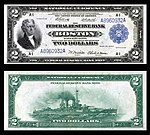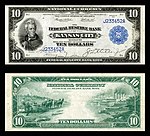

Federal Reserve Bank Notes are legal tender banknotes in the United States that were issued between 1915 and 1934, together with United States Notes, Silver Certificates, Gold Certificates, National Bank Notes and Federal Reserve Notes.[1] They were specified in the Federal Reserve Act of 1913 and had the same value as other kinds of notes of similar value. Federal Reserve Bank Notes are different from Federal Reserve Notes in that they are backed by one of the twelve Federal Reserve Banks, rather than by all collectively. Federal Reserve Bank Notes were envisioned as a replacement for National Bank Notes, but that did not prove to be the case.[2] They were backed in a similar way to National Bank Notes, using U.S. bonds, but issued by Federal Reserve banks instead of by chartered National banks. Federal Reserve Bank Notes are no longer issued; the only U.S. banknotes still in production since 1971 are the Federal Reserve Notes.
Large size Federal Reserve Bank Notes were first issued in 1915 in denominations of $5, $10, and $20, using a design that shared elements with both the National Bank Notes and the Federal Reserve Notes of the time. Additional denominations of $1, $2, and $50 were issued in 1918 as an emergency replacement for Silver Certificates, which were temporarily removed from circulation under the Pittman Act.[3]
Small size Federal Reserve Bank Notes were printed as an emergency issue in 1933 using the same paper stock as 1929 National Bank Notes. They were printed in denominations of $5 through $100. The wording, "Or by like deposit of other securities" was added after the phrase, "Secured by United States bonds deposited with the Treasurer of the United States of America".[4] This emergency issue of notes was prompted by the public hoarding of cash due to many bank failures happening at the time. This also limited the ability of the National Banks to issue notes of their own. Small size Federal Reserve Bank Notes were discontinued in 1934 and have not been available from banks since 1945. As small size notes, they have brown seals and serial numbers, as do National Bank Notes of the era. But while they look very similar, and both have the words, "National Currency" across the top of the obverse, they had different issuers and are considered to be distinctly different types of bills.
| Large-size Federal Reserve Bank Notes: Series 1915/1918 | |||||||||||
|---|---|---|---|---|---|---|---|---|---|---|---|
| Image | Value | Dimensions | Main Color | Description | |||||||
| Obverse/Reverse | Obverse | Reverse | |||||||||

|
$1 | Large-size note 7.375 x 3.125 inches (187 x 79 mm) |
Green; Black | George Washington | Eagle with flag. | ||||||

|
$2 | Large-size note 7.375 x 3.125 inches (187 x 79 mm) |
Green; Black | Thomas Jefferson | Battleship (New York Class, BB-34 and BB-35). | ||||||

|
$5 | Large-size note 7.375 x 3.125 inches (187 x 79 mm) |
Green; Black | Abraham Lincoln | Columbus in sight of land; landing of the pilgrims | ||||||

|
$10 | Large-size note 7.375 x 3.125 inches (187 x 79 mm) |
Green; Black | Andrew Jackson | Industry vignettes (farm and factory) | ||||||

|
$20 | Large-size note 7.375 x 3.125 inches (187 x 79 mm) |
Green; Black | Grover Cleveland | Transportation vignettes (land, sea, and air) | ||||||

|
$50 | Large-size note 7.375 x 3.125 inches (187 x 79 mm) |
Green; Black | Ulysses S. Grant | Panama between two ships | ||||||

|
$100 | Large-size proof 7.375 x 3.125 inches (187 x 79 mm) |
Green; Black | Benjamin Franklin | None, this denomination was never issued (proof only) | ||||||
| Small-size Federal Reserve Bank Notes: Series 1929 | |||||||||||
|---|---|---|---|---|---|---|---|---|---|---|---|
| Image | Value | Dimensions | Main Color | Description | |||||||
| Obverse/Reverse | Obverse | Reverse | |||||||||

|
$5 | Small-size note 6.125 x 2.625 inches (156 x 67 mm) |
Green; Black | Abraham Lincoln | Lincoln Memorial | ||||||

|
$10 | Small-size note 6.125 x 2.625 inches (156 x 67 mm) |
Green; Black | Alexander Hamilton | US Treasury Building | ||||||

|
$20 | Small-size note 6.125 x 2.625 inches (156 x 67 mm) |
Green; Black | Andrew Jackson | The White House | ||||||

|
$50 | Small-size note 6.125 x 2.625 inches (156 x 67 mm) |
Green; Black | Ulysses S. Grant | US Capitol Building | ||||||

|
$100 | Small-size note 6.125 x 2.625 inches (156 x 67 mm) |
Green; Black | Benjamin Franklin | Independence Hall | ||||||
|
| |||
|---|---|---|---|
| Topics |
| ||
| Coins |
| ||
| Currency |
| ||
| Related |
| ||